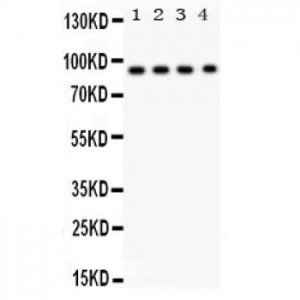More info
Overview
Long Name | Antibody Type | Antibody Isotype | Host | Species Reactivity | Validated Applications | Purification |
| dipeptidyl-peptidase 4 | Polyclonal | IgG | Rabbit | Human, Rat | WB | Immunogen affinity purified. |
Immunogen | ||||||
| A synthetic peptide corresponding to a sequence at the C-terminus of human CD26 (731-761aa QAMWYTDEDHGIASSTAHQHIYTHMSHFIKQ), different from the related mouse and rat sequences by three amino acids. | ||||||
Properties
Form | Lyophilized |
Size | 100 µg/vial |
Contents | Antibody is lyophilized with 5 mg BSA, 0.9 mg NaCl, 0.2 mg Na2HPO4, 0.05 mg NaN3. *carrier free antibody available upon request. |
Concentration | Reconstitute with 0.2 mL sterile dH2O (500 µg/ml final concentration). |
Storage | At -20 °C for 12 months, as supplied. Store reconstituted antibody at 2-8 °C for one month. For long-term storage, aliquot and store at -20 °C. Avoid repeated freezing and thawing. |
Additional Information Regarding the Antigen
Gene | DPP4 |
Protein | Dipeptidyl peptidase 4 |
Uniprot ID | P27487 |
Function | Cell surface glycoprotein receptor involved in the costimulatory signal essential for T-cell receptor (TCR)-mediated T-cell activation. Acts as a positive regulator of T-cell coactivation, by binding at least ADA, CAV1, IGF2R, and PTPRC. Its binding to CAV1 and CARD11 induces T-cell proliferation and NF- kappa-B activation in a T-cell receptor/CD3-dependent manner. Its interaction with ADA also regulates lymphocyte-epithelial cell adhesion. In association with FAP is involved in the pericellular proteolysis of the extracellular matrix (ECM), the migration and invasion of endothelial cells into the ECM. May be involved in the promotion of lymphatic endothelial cells adhesion, migration and tube formation. When overexpressed, enhanced cell proliferation, a process inhibited by GPC3. Acts also as a serine exopeptidase with a dipeptidyl peptidase activity that regulates various physiological processes by cleaving peptides in the circulation, including many chemokines, mitogenic growth factors, neuropeptides and peptide hormones. Removes N-terminal dipeptides sequentially from polypeptides having unsubstituted N-termini provided that the penultimate residue is proline. |
Tissue Specificity | Expressed specifically in lymphatic vessels but not in blood vessels in the skin, small intestine, esophagus, ovary, breast and prostate glands. Not detected in lymphatic vessels in the lung, kidney, uterus, liver and stomach (at protein level). Expressed in the poorly differentiated crypt cells of the small intestine as well as in the mature villous cells. Expressed at very low levels in the colon. |
Sub-cellular localization | Dipeptidyl peptidase 4 soluble form: Secreted. Note: Detected in the serum and the seminal fluid. |
Sequence Similarities | Belongs to the peptidase S9B family. DPPIV subfamily. |
Aliases | CD26 antigen antibody|ADA-binding protein antibody|ADABP antibody|ADCP 2 antibody|ADCP-2 antibody|ADCP2 antibody|Adenosine deaminase complexing protein 2 antibody|CD 26 antibody|CD26 antibody|CD26 antigen 3 antibody|Dipeptidyl peptidase 4 antibody|Dipeptidyl peptidase 4 soluble form antibody|Dipeptidyl peptidase IV antibody|Dipeptidyl peptidase IV membrane form antibody|Dipeptidyl peptidase IV soluble form antibody|Dipeptidyl peptidase, intestinal antibody|Dipeptidylpeptidase 4 antibody|Dipeptidylpeptidase IV (CD26, adenosine deaminase complexing protein 2) antibody|Dipeptidylpeptidase IV antibody|DPP 4 antibody|DPP IV antibody|DPP IV estoenzyme antibody|DPP4 antibody|DPP4_HUMAN antibody|DPPIV antibody|Intestinal dipeptidyl peptidase antibody|T cell activation antigen CD26 antibody|T-cell activation antigen CD26 antibody|TP 103 antibody|TP103 antibody |
Application Details
| Application | Concentration* | Species | Validated Using** |
| Western blot | 0.1-0.5μg/ml | Human, Rat | AssaySolutio's ECL kit |
AssaySolution recommends Rabbit Chemiluminescent WB Detection Kit (AKIT001B) for Western blot. *Blocking peptide can be purchased at $65. Contact us for more information

Anti- CD26 antibody, ASA-B0368, Western blotting
All lanes: Anti CD26 (ASA-B0368) at 0.5ug/ml
Lane 1: Rat Liver Tissue Lysate at 50ug
Lane 2: 22RV1 Whole Cell Lysate at 40ug
Lane 3: HEPG2 Whole Cell Lysate at 40ug
Lane 4: SMMC Whole Cell Lysate at 40ug
Predicted bind size: 88KD
Observed bind size: 88KD
All lanes: Anti CD26 (ASA-B0368) at 0.5ug/ml
Lane 1: Rat Liver Tissue Lysate at 50ug
Lane 2: 22RV1 Whole Cell Lysate at 40ug
Lane 3: HEPG2 Whole Cell Lysate at 40ug
Lane 4: SMMC Whole Cell Lysate at 40ug
Predicted bind size: 88KD
Observed bind size: 88KD



